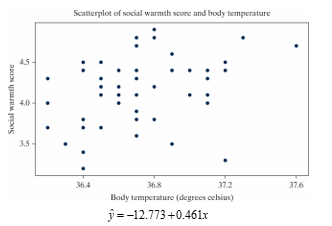Multiple Choice
Social warmth is a term referring to the feeling of being connected to others. A study published in PLoS One in 2016 looked at a potential relationship between physical warmth (body temperature) and social warmth among a group of 54 volunteers (Inagki et al.) . These volunteers had their oral temperature taken by a registered nurse and then assessed themselves using a scale of 1 to 5 on twelve items related to a feeling of social connection for which the average was recorded. Higher average scores indicated higher levels of social warmth. The theory was that the thermoregulatory system, which helps maintain a relatively warm internal body temperature, may also help people assess feelings of social connection. Below is a scatterplot and least-squares regression line of the data. 
-How would you interpret the slope of the regression line in the context of the study?
A) The correlation coefficient between body temperature and social warmth score is 0.461.
B) The predicted social warmth score when body temperature is zero degrees Celsius is -12.773.
C) A one degree Celsius increase in body temperature is associated with a predicted 0.461 increase in social warmth score.
D) About 46.1% of variability in social warmth scores can be explained by body temperature.
Correct Answer:

Verified
Correct Answer:
Verified
Q55: Annual measurements of the number of powerboat
Q56: Babies born with low birth weights (less
Q57: If the correlation coefficient between variables x
Q58: Data from gapminder.org on 184 countries was
Q59: Data from gapminder.org on 184 countries was
Q61: The following scatterplot displays the finish time
Q62: Babies born with low birth weights (less
Q63: Social warmth is a term referring to
Q64: Babies born with low birth weights (less
Q65: The following scatterplot displays the finish time